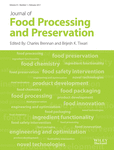Antioxidant Peptidic Particles for Delivery of Gallic Acid
The authors report no conflicts of interest and alone are responsible for the content and writing of the article.
Abstract
A whey protein isolate (WPI) solution was hydrolyzed to a highly antioxidant hydrolysate (WPH) and particulated by ethanol addition to encapsulate gallic acid (GA). Particle-forming peptides were cross-linked with citric acid by several procedures including GA charging–cross-linking–desolvation (where the hydrolysate was charged with GA, then cross-linked with citric acid, and finally desolvated), cross-linking–GA charging–desolvation (where the hydrolysate was cross-linked, then charged with GA and finally desolvated), and GA charging–desolvation–cross-linking (where the hydrolysate was charged with GA, then desolvated to particles and finally particles were cross-linked with citric acid). The cross-linking–GA charging–desolvation method formed smaller particles and provided a higher encapsulation efficiency. ζ-Potential measurements showed that isoelectric point of all three kinds of peptidic particles was almost 4.3. Scanning electron microscopy indicated spherical and almost uniformly shaped particles. GA release kinetics and particle size monitoring informed that core is released mostly by a diffusion-based mechanism, not particle bursting.
Practical Applications
Results suggest that potentially bioactive peptides can be used as the matrix-forming biomaterial for the nanoencapsulation of gallic acid. The generated capsule has dual functional benefits by which a nutraceutical has been enclosed within another bioactive component. It can be employed at the formulation of value-added products.




